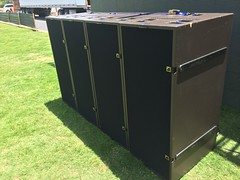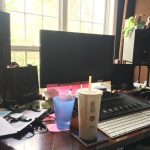State of the Mix 2019: Sweeping the Subs
Let’s talk about subs. When I set up the subs, it’s important for me to have a smooth transition from the main PA for the music I’m mixing. This is probably a little different from ways I approached things years ago. Back then I usually ended up putting a big haystack in the subs. When engineers refer to a “haystack”, we’re talking about how the measurement of our subs looks which in this case is sort of a haystack-looking shape down in the sub-lows. I’ve moved on from this, though.
These days you’ll likely still see my measurement trace rise in the sub-lows for a PA I’m tuning or mixing on, but it probably won’t look like a haystack. That rise relates to the way dual-FFT’s work and is something I’ve written about, but losing the haystack comes from ongoing frustrations I’ve had related to mixing bass guitar for live sound.
Bass guitar is a mind-boggling instrument for me at times because at a fundamental level it’s such a simple instrument. I mean, it’s really just one note being played the majority of the time. Tonally it’s also pretty clean on the harmonic side of things especially in comparison to other instrumentation. In spite of this, getting the bass guitar right can be a challenge at times for engineers of all skill levels.
One of the ongoing challenges with the bass for me is getting even level from the instrument. Part of that comes down to the player and some help on my end using tasteful compression, but what I’m talking about today isn’t a compression thing or a playing thing or a tonal thing. It’s a PA thing.
What I’ve noticed with a haystack of subs is when a bass player is playing higher notes and drops down to the lowest octave, those notes can suddenly jump out. Sometimes I’d get the opposite problem where the bass is wonderful and deep one minute, and then it disappears the next as the player goes higher. This gets especially problematic when the bass is playing notes right around the crossover point between the mains and the subs so notes go from being lost to jumping out. While this issue affects the mix, it’s not a mixing problem. This is a system problem.
So when I’m in an environment where I feel like the sub levels are off, I like to run a log sweep starting around 200 Hz down to 20 Hz which gives me coverage through the lows of the main PA down into the subs. As I’m running the sweep, I’m listening for a smooth, even perceived level as the frequency descends.
One thing I’ll often hear doing this are periodic dips in level which are typically related to nulls resulting from speaker configuration or deployment and/or acoustics. Listening in different areas of the room can help confirm this. Fixing these requires looking at acoustic treatment and/or redesigning and deploying the loudspeaker system.
An exception to this might be a dip around the crossover point between the subs and the mains because a dip at this point could be an issue with the sub alignment or even the crossover configuration. Outside of that, though, I don’t worry too much about those dips in level because I am rarely in a situation where they can be dealt with in the moment.
What I’m listening for with the sweep is primarily a big jump in level in the 70-120 Hz range. If the level jumps, that’s a sign to me the subs are probably too loud and should be turned down.
Now I can already hear it:
“But…but…but I can’t turn the subs down! How will I get my kick drum to kick me in the chest???
Well, you can mix like an adult and use a low filter or a low shelf to bump the lows as needed. OR, even better, you can take a look at your sources like your kick drum and mic placement and even overall placement of the kit. Did you know where you put the kick drum physically on stage can affect the low end it provides?
The PA is there to reproduce our mix. The PA is NOT there for us to use as a mixing tool.
Now, I know not everyone might agree with this idea and maybe there are styles of music that might benefit from a different approach, but I’m pretty skeptical in that regard. I look at subs as low frequency extension to fill out what the mains can’t do, and I also believe this is a better approach when you are doing anything with organic music featuring musicians playing actual instruments. Taking another approach risks separating the sub content from the music which can lead to a slew of potential issues such as what I’ve been talking about in relation to having a haystack.
Setting up the subs as the low-frequency portion of a sound system makes it easier to to create a mostly neutral palette to mix on. I find when the PA is designed and optimized this way, it gives me total control over the mix at the console. My EQ’s and compressors work better this way, and my mixes translate outside of the room much better as well which is important in today’s world of streaming FOH mixes. My clients also tend to echo these thoughts as well.
So, if you’re struggling with bass and want a quick way to check your sub level and alignment, try running a sweep through them and into the mains. You can probably find one to download floating around the internet. I have an app on my phone called Signal Suite I use to do this, and in a pinch most of the consoles I end up on have a separate feed to the subs I can adjust if I can’t get at the system’s DSP. And if you find your subs aren’t behaving quite right and aren’t sure you want to make the changes yourself, I’d be happy to come help you get your system tuned. Just reach out to me through my Contact page.


 Previous Post
Previous Post Next Post
Next Post



About the subs ‘kicking in the chest’ one church I visited reserved seats for visitors on the front row. Three feet from the ground subs. I felt like my insides were being emulsified and had to move. Another church had both ground subs and hanging subs. Each time the kick hit what hair I have left moved as well as my pants’ legs.
Having subs in the air and on the ground isn’t indicative of the experience someone will have in the audience. In 9 out of 10 cases, that comes down to what the mix engineer is doing which also may be based on feedback and direction he’s getting from a variety of sources.